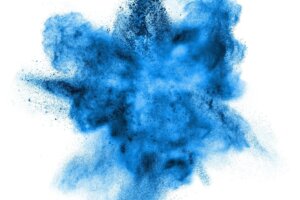Why You Have a Favorite Color


Written and verified by the psychologist Valeria Sabater
Did you know that, many years ago, science discovered that the color yellow stimulates the appetite? This is the reason why food industries use it for their advertising and logos. It’s a kind of subliminal message for the brain. In fact, we experience endless physiological and psychological processes every time those light rays hit our retinas.
What’s more, science suggests that your preference for one color or another isn’t a purely voluntary act. We all respond emotionally and evolutionarily to color. Each tonality generates a feeling, a sensation, a physiological activation, or even a series of specific impulses, as in the case of the color yellow.
Furthermore, we can’t ignore the cultural impregnation that we’ve given to certain tones. For example, the color black has long been associated with the grieving process and is the shade of clothing worn by those who’ve lost a loved one. Today, black is also associated with elegance.
We all have our own favorite colors. Maybe you have a weakness for delicate lavender, vibrant vermilion or turquoise, or the more muted olive green. Why do our preferences vary? Is there an explanation? Let’s find out.
The color blue tends to be most people’s favorite color.

Why do you have a favorite color (and why is it more likely to be blue)?
What are your three favorite colors? It’s extremely likely that you’ve included blue in your list. In fact, the color blue has been the favorite of most people for centuries. This is due, in part, to the fact that humans have evolved associating this color with survival, calm, and health.
Living in settings close to aquatic environments made it easier for us to have resources to feed ourselves and survive. They were also places of great beauty (rivers, seas, lakes) endowed with light that generated feelings of well-being in our ancestors. That past imprint is still present in us.
A study conducted by the University of Texas (USA) conducted a striking experiment in Japan. They found that installing blue led lights on subway and train platforms prevents suicides. Although this pilot test was carried out on only one railway line, the data was revealing. The suicides were reduced by 84 percent. Somehow, the color blue has an impact on the brain. It invites introspection and calm. This explains why it attracts us as it does.
However, beyond blue, why do you have a favorite color? Why, since when you were young, have you had a preference for one color over another?
Behind every color, there’s a story (the theory of ecological valence)
The valence theory was coined by Dr. Karen Schloss in a study published in the journal, PNAS. Apparently, in our mental registers, no color is neutral: we give them all specific meanings. For example, a five-year-old girl is likely to have a preference for pink because of the cultural perceptions she’s been brought up with.
Our personal histories and subjective experiences condition us when it comes to feeling preference for one color or another. The media and advertising also have a great deal of influence. In fact, it’s often enough to have an experience of great emotional intensity for your mind to feel a preference for a particular color.
For example, if the person you fell in love with was wearing a green shirt the day you met them, chances are that it’s now your favorite color. This also explains why, over time, your predilection for one color might change to another.

Colors and human personality
We all have a favorite color, and it’s most likely not brown. In fact, this color arouses in your brain a series of uncomfortable sensations. It’s associated with dirt, debris, and decomposition. Beyond these instinctive and cultural responses, lies the personality factor.
The color red, for example, is among the favorites of dynamic, extroverted, and passionate people. It’s the most striking color for the human eye; it never goes unnoticed. On the other hand, the most introverted, patient, and introspective personalities tend to prefer green.
Those who are optimistic, good communicators, and with a great sense of humor, may have orange among their favorites. Our personality is another variable that could explain this inclination for certain tones and not others.
Girls around five to six years old tend to be fixated on the color pink due to social and cultural factors. However, before reaching adolescence, their preferences tend to change.
Colors are made from stories
Your life experiences, culture, personality, and even your instincts play a decisive role in your fascination with a particular color or colors. In fact, it could be said that both cultural and biological origins are combined. This makes it even more interesting.
If you want to discover why you have a favorite color, ask yourself the following questions. How does this color make me feel? What do I associate with this color? What memories or what images does it bring to mind? Perhaps, by reflecting on these questions, you’ll find the answer.
All cited sources were thoroughly reviewed by our team to ensure their quality, reliability, currency, and validity. The bibliography of this article was considered reliable and of academic or scientific accuracy.
- Matsubayashi T, Sawada Y, Ueda M. (2012). Does the installation of blue lights on train platforms prevent suicide? A before-and-after observational study from Japan. Journal of Affective Disorders. 8. 50-51. Published online 11 September 2012. doi: 10.1016/j.jad.2012.08.018 , 2012 .
- Palmer SE, Schloss KB. An ecological valence theory of human color preference. Proc Natl Acad Sci U S A. 2010 May 11;107(19):8877-82. doi: 10.1073/pnas.0906172107. Epub 2010 Apr 26. PMID: 20421475; PMCID: PMC2889342.
This text is provided for informational purposes only and does not replace consultation with a professional. If in doubt, consult your specialist.








